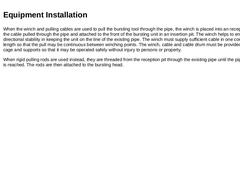
|
When the winch and pulling cables are used to pull the bursting tool through the pipe, the winch is placed into an reception pit, and the cable pulled through the pipe and attached to the front of the bursting unit in an insertion pit. The winch helps to ensure the directional stability in keeping the unit on the line of the existing pipe. The winch must supply sufficient cable in one continuous length so that the pull may be continuous between winching … |

|
The bursting of the old pipe can be performed as a continuous action if the replacement pipe is continuous and the winch with continuous cable is used. When rigid rods are used as a pulling unit the bursting operation temporarily halts, for each rod sections to be unthreaded and removed from the reception pit. In addition, when the pipe is installed in segments, the preparation of each successive pipe segment also interrupts the operation, as it includes … |
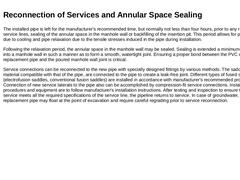
|
The installed pipe is left for the manufacturer's recommended time, but normally not less than four hours, prior to any reconnection of service lines, sealing of the annular space in the manhole wall or backfilling of the insertion pit. This period allows for pipe shrinkage due to cooling and pipe relaxation due to the tensile stresses induced in the pipe during installation. Following the relaxation period, the annular space in the manhole wall may … |
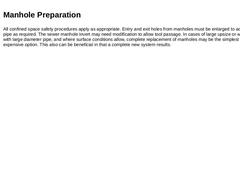
|
All confined space safety procedures apply as appropriate. Entry and exit holes from manholes must be enlarged to accept the new pipe as required. The sewer manhole invert may need modification to allow tool passage. In cases of large upsize or when dealing with large diameter pipe, and where surface conditions allow, complete replacement of manholes may be the simplest and least expensive option. This also can be beneficial in that a complete new … |
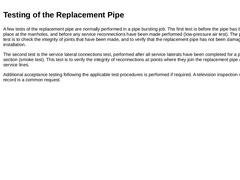
|
A few tests of the replacement pipe are normally performed in a pipe bursting job. The first test is before the pipe has been sealed in place at the manholes, and before any service reconnections have been made performed (low-pressure air test). The purpose of this test is to check the integrity of joints that have been made, and to verify that the replacement pipe has not been damaged during installation. The second test is the service lateral connections … |
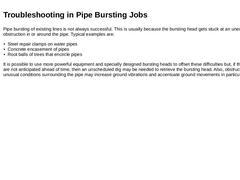
|
Pipe bursting of existing lines is not always successful. This is usually because the bursting head gets stuck at an unexpected obstruction in or around the pipe. Typical examples are: - Steel repair clamps on water pipes
- Concrete encasement of pipes
- Root balls of trees that encircle pipes
It is possible to use more powerful equipment and specially designed bursting heads to offset these difficulties but, if the difficulties are not anticipated ahead … |
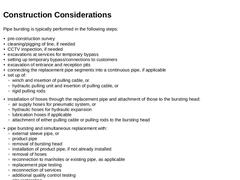
|
Pipe bursting is typically performed in the following steps: - pre-construction survey
- cleaning/pigging of line, if needed
- CCTV inspection, if needed
- excavations at services for temporary bypass
- setting up temporary bypass/connections to customers
- excavation of entrance and reception pits
- connecting the replacement pipe segments into a continuous pipe, if applicable
- set up of:
- winch and insertion of pulling cable, or
- hydraulic pulling unit and insertion …
|

|
The bid documents are prepared by the owner/engineer, and should provide the contractor information needed to prepare competitive bids for construction. Typical bid documents should include the following: Invitation for Bids, Scope of Work, Plans, Specifications, Site Investigation Report, Procedures for Protecting Existing Structures and Site Features, Inspection Procedures, Minimum Performance Requirements, and Performance Period. |

|
Minimum performance requirements are established in the contract documents to ensure that the pipeline, as installed, will perform as designed. The criteria typically established for gauging performance include hydraulic characteristics, grade tolerances, water infiltration, internal pressure tests, and protection of adjacent structures. Causes for rejection of a pipe replacement job include physical defects of the pipe, such as concentrated ridges, … |
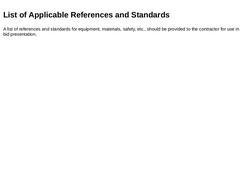
|
A list of references and standards for equipment, materials, safety, etc., should be provided to the contractor for use in planning and bid presentation. |
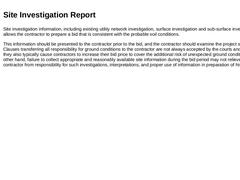
|
Site investigation information, including existing utility network investigation, surface investigation and sub-surface investigation, allows the contractor to prepare a bid that is consistent with the probable soil conditions. This information should be presented to the contractor prior to the bid, and the contractor should examine the project site on his own. Clauses transferring all responsibility for ground conditions to the contractor are not … |

|
To ensure a safe, efficient, high-quality project, the owner should present a list of minimum qualifications to the potential contractors. These minimum qualifications typically include a minimum number of pipe bursting projects successfully completed by the contractor. The contractor should furnish a list of references where pipe bursting was used in similar ground conditions. Financial data on the contractor and any subcontractors should also be … |
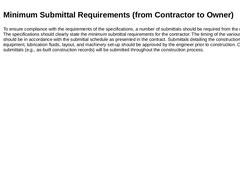
|
To ensure compliance with the requirements of the specifications, a number of submittals should be required from the contractor. The specifications should clearly state the minimum submittal requirements for the contractor. The timing of the various submittals should be in accordance with the submittal schedule as presented in the contract. Submittals detailing the construction process, equipment, lubrication fluids, layout, and machinery set-up … |
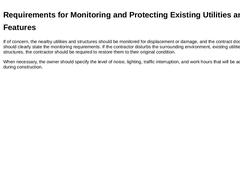
|
If of concern, the nearby utilities and structures should be monitored for displacement or damage, and the contract documents should clearly state the monitoring requirements. If the contractor disturbs the surrounding environment, existing utilities, or structures, the contractor should be required to restore them to their original condition. When necessary, the owner should specify the level of noise, lighting, traffic interruption, and work hours … |
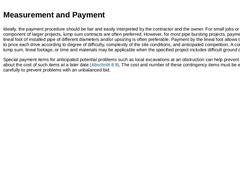
|
Ideally, the payment procedure should be fair and easily interpreted by the contractor and the owner. For small jobs or for a small component of larger projects, lump sum contracts are often preferred. However, for most pipe bursting projects, payment by the lineal foot of installed pipe of different diameters and/or upsizing is often preferable. Payment by the lineal foot allows the contractor to price each drive according to degree of difficulty, … |
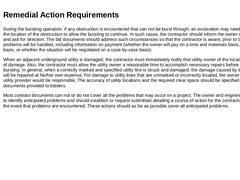
|
During the bursting operation, if any obstruction is encountered that can not be burst through, an excavation may need to be made at the location of the obstruction to allow the bursting to continue. In such cases, the contractor should inform the owner or the engineer and ask for direction. The bid documents should address such circumstances so that the contractor is aware, prior to bid, how these problems will be handled, including information … |
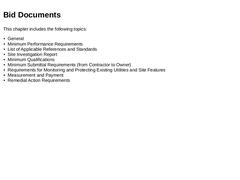
|
|

|
Submittals requested by the owner from the contractor are to ensure compliance with the project specifications. In addition, they provide the basis for monitoring details of the project. These submittals, or portions of, can be provided at various points during the procurement and construction process. The submittals of interest will be discussed in this section. |

|
Submittals should include shop drawings, catalog data, and manufacturers technical data showing complete information on material composition, physical properties, and dimensions of new pipe and fittings. A certificate of compliance with specifications for materials needs to be furnished. Manufacturer's recommendations for handling, storage, and repair of pipe and damaged fittings should also be included. |
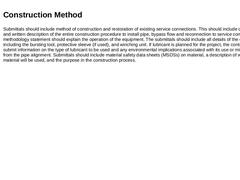
|
Submittals should include method of construction and restoration of existing service connections. This should include detail drawings and written description of the entire construction procedure to install pipe, bypass flow and reconnection to service connections. A methodology statement should explain the operation of the equipment. The submittals should include all details of the equipment including the bursting tool, protective sleeve (if used), … |

|
The contractor needs to submit information on how the temporary diversion for the pipeline will be provided, and verify that the pumps and by-pass lines shall be of adequate capacity and size to handle all necessary flows during the period the line is out of service. Continuous service of connections to the line during the execution of work is expected to be a responsibility of the contractor, as well as clean-up, repair and property damage cost … |
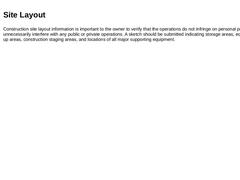
|
Construction site layout information is important to the owner to verify that the operations do not infringe on personal property or unnecessarily interfere with any public or private operations. A sketch should be submitted indicating storage areas, equipment set-up areas, construction staging areas, and locations of all major supporting equipment. |

|
The contractor must provide verification of qualifications to the owner. The contractor should furnish background information on key personnel to allow the owner to ensure they have adequate experience. For prior job references, complete names, affiliations, addresses, and telephone numbers should be furnished so the owner may contact the references to verify satisfactory prior performance. Supporting financial data on the company should also be … |
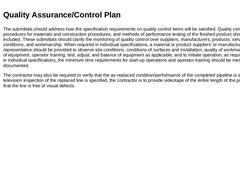
|
The submittals should address how the specification requirements on quality control items will be satisfied. Quality control procedures for materials and construction procedures, and methods of performance testing of the finished product should be included. These submittals should clarify the monitoring of quality control over suppliers, manufacturers, products, services, site conditions, and workmanship. When required in individual specifications, … |
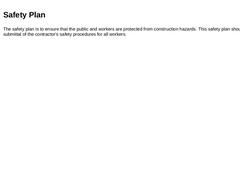
|
The safety plan is to ensure that the public and workers are protected from construction hazards. This safety plan should include a submittal of the contractor's safety procedures for all workers. |